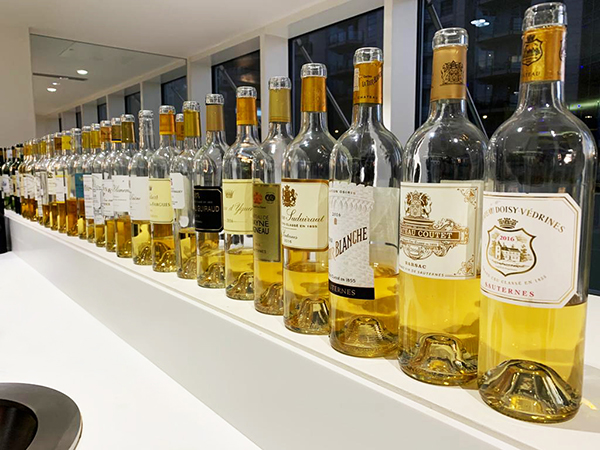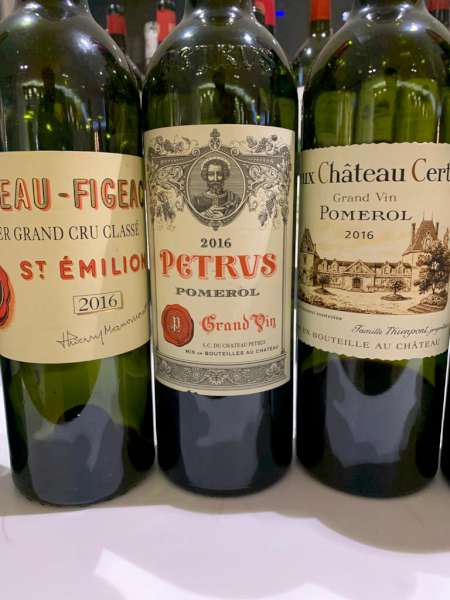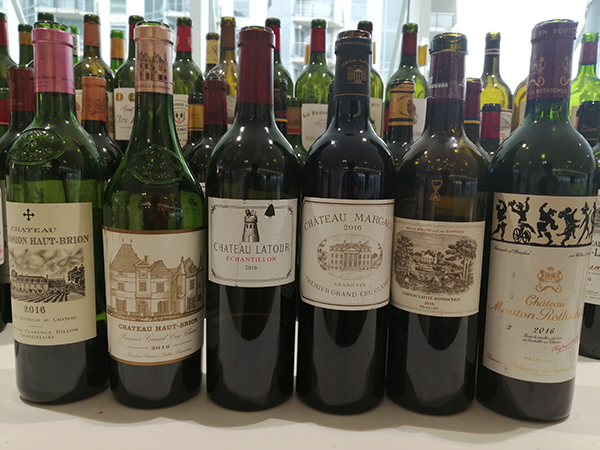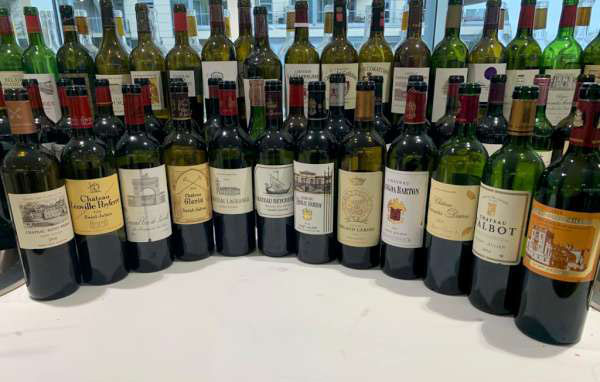For over 40 years leading figures of the British wine trade have assembled every January to blind taste their way through all of the top wines of Bordeaux from the latest vintage in a marathon three day tasting. For many years this took place in Southwold in Suffolk, but it has now moved to the modern, purpose-built tasting room of Farr Vintners on the banks of the river Thames in Battersea Reach.
This year’s vastly experienced panel of experts included seven Masters of Wine, the buyers of the leading UK merchants and wine writers Steven Spurrier (the man who invented blind tastings!), Jancis Robinson and Neal Martin. Look out for Jancis and Neal’s comprehensive reviews in due course.

We started with the dry white wines. These were good rather than exceptional with attractive fruit and fresh acidity in balance. These wines are approachable now and I see no reason to keep them in the cellar. Our surprise winner was a first time entrant. The new white wine of Cheval Blanc is called Le Petit Cheval Blanc and it impressed by combining the best elements of Bordeaux and Loire white wines. This Sauvignon Blanc based wine was both steely and fresh but had the complexity and depth of the best barrel-fermented white Bordeaux. Well done also to Château de Fieuzal whose wine came second and top of the Pessac-Leognans. The sweet wines of Sauternes were full bodied and concentrated but we didn’t find the overt botrytic complexity of a truly great vintage. The winner was a powerful and age-worthy La Tour Blanche with Climens, Suduiraut and d’Yquem close behind.

On day two we got going on the reds at 9.30 am and, as always, it was Bordeaux’s right bank that we looked at first. There were three flights (of 12 wines each) that featured wines in the £15 to £40 per bottle price range and the winner here was Denis Durantou’s Les Cruzelles from Lalande Pomerol which outscored many well-known (and more expensive) Saint Emilions and Pomerols. This plump Merlot-dominated beauty was full-bodied, succulent and fleshy; opulent but finely balanced. Yet another stunning success for this property – whose wines sell at around £200 per dozen. If you’re going to buy any moderately priced right bank 2016, this is the one. In the next price bracket our winner was Canon La Gaffelière. This beautifully balanced Saint Emilion combined the modern and traditional winemaking styles. It was ripe but unforced. Close behind were excellent efforts from Trottevieille and Clos St Martin. Moving up to the bigger names of Saint Emilion, there was a superb effort from Belair Monange. This is certainly a property on the up. In the 19th and early 20th centuries Belair was regarded as one of the great names of the region but it fell into decline with some terrible performances in the 70’s, 80’s and 90’s. Now under the ownership of the Moueix family this wine seems to get better every year and is fast becoming a superstar of Saint Emilion. Seamless and refined with pure red fruit, this is a wine that doesn’t shout to be noticed. It represents the future of Saint Emilion as châteaux move away from oak and extraction. There was no surprise that, yet again, our winner here was Ausone – a regular occurrence! However it was closely followed by Figeac (probably the best wine made here since 1959) and an Angélus that displayed admirable balance and precision – with the lovely Canon hot on its heels. The final vintage of the old regime at Troplong Mondot was in last place but we look forward to seeing the exciting changes here bear fruit in the coming years.

The 2016 Pomerols are fabulous. The vintage’s natural freshness pairing well with the exuberance of ripe but balanced Merlot fruit. All the famous names here showed really well with more than a dozen of them averaging well over 16 points. Our winner was Lafleur with Vieux Château Certan close behind. In tie for third place were Eglise Clinet and Pétrus. These 4 Pomerols ended up in the top 6 rankings overall. They are beautiful expressions of Pomerol and represent the very best achievements of right bank Bordeaux of the modern era.

Over the river to Pessac Léognan where we found the Merlot and Cabernet Sauvignon based wines to be finely balanced and attractive. Our winner, unsurprisingly, was Haut Brion – closely followed by stablemate La Mission. There were superb efforts from Les Carmes Haut Brion (the second strong performance in a row for this up-and-coming star) with Pape Clement, Domaine de Chevalier and Smith Haut Lafitte all excellent.
In Margaux we tend to find that Château Margaux, Palmer and Rauzan Ségla are always at the top. This year they were joined by Brane Cantenac that narrowly made it to second place in the appellation. The 2016 Margaux seem a little less good than the brilliant 2015s here, but it’s another great vintage with some lovely, polished and refined expressions of balanced Bordeaux.
Moving north we arrived at Saint Julien and what a wonderful set of wines we found here. These are the epitome of great claret and it’s hard to go wrong buying any St Julien 2016. They have intensity and power allied with finesse and sophistication. These are not blockbuster but are finely poised and classic in structure. All three Léovilles are brilliant with the slightly more seductive Poyferré taking top spot. Ducru Beaucaillou was also on top form. Of the more modestly priced wines of the appellation, Langoa Barton did brilliantly and is not far off the quality of its big brother. At less than half the price of Léoville Barton this looks like the bargain buy here.

There is no doubt in my mind that 2016 is a brilliant vintage in Pauillac that clearly ranks among – and maybe beats – years like 2010, 2009 and 2005. Our children will come to regard this year as our generation see vintages like 1959, 1961 and 1982. It really is that good. On the top of the pile by a whisker was the awesome Mouton Rothschild. This is a wine that reminds me of the 1982 and 1986 produced here, but I think that it is potentially even better. Just behind it was another stunning vintage of Latour. These are landmark wines that will become legends of the future. However, it must be said that the lesser-ranked neighbours are producing greater wines than ever before and the gap is closing – in quality but not in price. The 2 Pichons were neck and neck and continue their incredible run of high quality. Right up with them in a photo finish were Lynch Bages and Grand Puy Lacoste. These four châteaux made wines that every Bordeaux collector should have in their cellar. These Cabernet Sauvignon classics will last for decades but their refinement of structure will make them approachable earlier than was the case with years of equal stature such as 1961, 2005 and 2010.

Finally we come to Saint Estèphe where the best wines will rival the top names of Pauillac and Saint Julien. It was also the scene of the biggest shock of the tasting when – yet again – lowly unclassified Château Meyney took on the big guns and ultimately shared the top spot. An incredible performance for a wine that currently sells at £260 per dozen (although maybe not for much longer!). Meyney was in a dead heat with Calon Ségur (another vastly improved property on a fine run of form) with Montrose and Cos d’Estournel close behind. Bargain hunters should also look at Lafon Rochet which performed brilliantly and is surely the greatest wine ever made here! Often this commune’s wines can be difficult to taste when young but in 2016 they combine concentration with smoother, rounded and well-integrated tannins.
In conclusion, in all the years that I have been taking part in this event, I cannot recall a vintage that was as consistently good as 2016. There were very few poor wines in this tasting with average scores probably higher than in any other vintage that we have assessed.
2016 is really a perfect modern vintage. The wines have the fresh acidity of a cooler vintage, but with the purity and ripeness of fruit akin to 2010 or 2005. The tannins are more refined than in any vintage I have tasted in Bordeaux – persistent and plentiful but fine and superbly integrated. The result is a set of wines that are harmonious and should have long, open drinking windows. The fact that winemakers have moved away from heavy extraction, late picking and high alcohols adds to their quality – these are wines you want to keep going back to rather than being overwhelmed by a single glass. It’s hard to compare it to other vintages but taking the great vintages of the last 20 years, here are my thoughts:
2000 – a great mature vintage but 2016 will be better (and won’t take as long to be ready to drink).
2005 – similar to 2016 but I think 2016 is better and certainly the tannins are softer and the wines are better balanced and less backward.
2009 – this is a blockbuster year but some of the wine are a bit too decadent. 2016 is cooler and classier.
2010 – this is the closest comparison. Which is better? It’s hard to say. The 2010’s probably have more power but the 2016’s are finer and more subtle.

See also :-